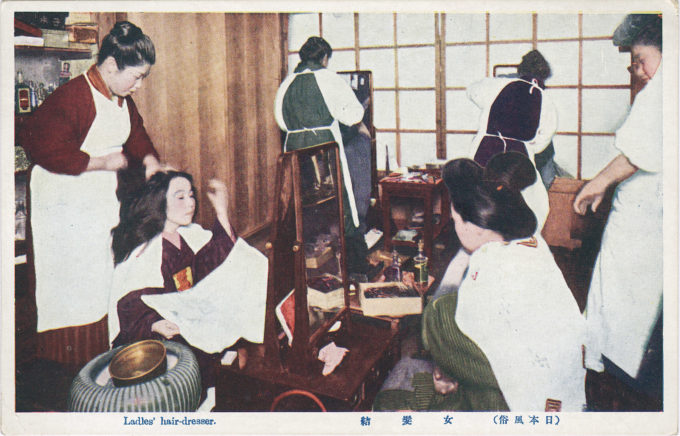
“Ladies’ hair-dresser”, c. 1930. Many modern geisha now use wigs in their professional lives due to a shortage of hairstylists (only five in 2004 in Kyoto), while maiko will still use their natural hair. It was in the 17th century that the traditional shimada hairstyle, a popular type of chignon worn by many established geisha, developed. In the 18th century, a more elaborate version of the shimada became popular – the torobin shimada [lantern person], featuring extra folds of hair that would stick out on the sides, resembling a toro lantern. It is often seen in ukiyo-e woodblock prints of the time.
See also:
Hair fashion, c. 1910.
Changing fashion (“Shampoo Coiffure”), c. 1910.
“On my way back to the okiya, it didn’t matter to me that my poor scalp felt the way clay must feel after the potter has scored it with a sharp stick. Every time I caught a glimpse of myself in the glass of a shop, I felt I was someone to be taken seriously; not a girl anymore, but a young woman.
“When I reached the okiya, Auntie made me model my hair for her and said all sorts of kind things. Even Pumpkin couldn’t resist walking once around me admiringly … And what do you suppose Mother’s reaction was? She stood on her tiptoes to see better – which did her little good, because already I was taller than she was – and then complained that I probably ought to have gone to Hatsumomo’s hairdresser rather than Mameha’s.
“… Every young geisha may be proud of her hairstyle at first, but she comes to hate it within three or four days. Because you see, if a girl comes home exhausted from the hairdresser and lays her head down on a pillow for a nap as she did the night before, her hair will flatten out of shape. The moment she awakens, she’ll have to go right back to the hairdresser again. For this reason, a young apprentice geisha must learn a new way of sleeping after he hair is styled for the first time.
“She doesn’t use an ordinary pillow any longer, but a takamakura – which I’ve mentioned before. It’s not so much a pillow as a cradle for the base of the neck. Most are padded with a bag of wheat chaff, but still they’re not better than putting your neck on a stone.
“You lie there on your futon with your hair suspended in the air, thinking everything is fine until you fall asleep; but when you wake up, you’ve shifted somehow so that your head had settled back on the mats, and your hairstyle is as flat as if you hadn’t bothered to use a tall pillow in the first place.”
– Memoirs of a Geisha, by Arthur Golden, 1999

